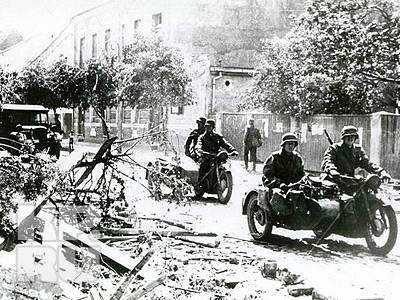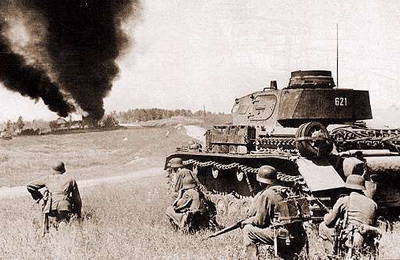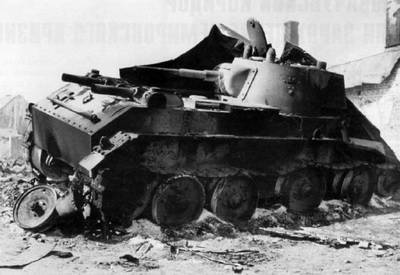Tragedy in Belarus (1941)
The whole Red Army of the 1941 model of the year was reflected in the personality of the commander of Zapovo as if in a drop of water. He was a commander who quickly moved to the highest post because of repressions that had outgrown the army. But the version that he did not have sufficient training, which explained everything so easily and later served as a reason for his execution, is not the truth. Assigning only him responsible for what happened in 1941 in June, we thereby undertake to assert that another person in his place could correct the situation. It’s as if the situation in which the Western front would stand under the blows of the Germans does not even require proof. Some particularly savvy specialists claim that it was enough to put the existing T-34 and KV tanks into ambushes, as General Katukov later did near Moscow and the German tanks would have burned even before Baranavichy. But such people are bewildered by the quite reasonable question: “where are these ambushes to be organized?”. Apparently, Pavlov should have known the exact routes of the offensive of the German troops. But he did not know, and when he found out it was already too late.

Before judging Pavlov, one must put oneself in his place and consider the events, taking into account the data that were at his disposal. In itself, the location of the Bialystok bulge already suggested an operation on the environment, and this, of course, Pavlov knew. The whole point was that such an operation could have been carried out in different ways, which presented difficulties for both the defenders and the attackers. The main thing for those and for others was the question of determining the point of convergence of the advancing tank wedges. A similar operation was expected from the Germans, but to a small depth, with an attempt to form a boiler in the area of Volokovysk and Baranovichi.
Historical events, as often happens, push randomness forward. Something similar happened in 1941 in the Brest region. Taught by the bitter experience of 1939, then Gudarian was already trying to seize the Polish Brest Fortress, in the 1941 campaign he planned a double roundabout maneuver. Figuratively speaking, the fast Heinz “blew into the water”, instead of throwing his tank group along the highway near Brest, he drove it into a terrain impenetrable for tanks south and north of Brest. The infantry was supposed to take the fortress and storm the city. And so, beginning the morning of June 22 "for health", Gudarian finished it "for peace." The Germans captured many bridges, but many of them were suitable for infantry and light equipment, not for tanks. The tank group spent the whole day on June 22 fighting the terrain, trying to get out on the highway. By the evening of June 22, many units had not yet crossed the Bug. At the end of the day, parts 3 and 4 of the tank divisions of the 49 motorized corps of the Germans that appeared on the highway buried in a burnt bridge over Mukhovets in the Bulkovo region. Gudarian was annoyed at this beginning, but it was his delay that played one of the key roles in the unfolding drama of the Western Front.
By the end of the day, Pavlov and his staff were evaluating the events and trying to develop countermeasures. Pavlov did not know everything that we know today, he was guided by intelligence data. What did he see? The first reconnaissance report from 14: 00 reported that the enemy was making every effort to take Grodno, the second from 16: 15 indicated that the main efforts of the enemy aviation were noted at the site of Grodno-Lida. The evening final intelligence report from 22 hours contained the following data. With the dawn, the German units crossed the border in the amount of up to 30-32 infantry divisions, 4-5 tank, 2 motorized, 40 artillery regiments, about 4-5 air regiments, one airborne division. And here the scouts made a slight mistake, the forces acting against the district were determined approximately correctly, it was especially emphasized that a tank group had crossed the border to the right, whose forces evaluated 4 tank and motorized divisions.

But a completely different picture was the distribution of these troops. It was stated that 2 tank and 2 motorized divisions were attacking Grodno, in fact there was only infantry there. But already 2-3 tank connections remained automatic to other directions. Intelligence “found” another tank division on the southern face of the Belostok jut, but there were no tanks there either, only the infantry was reinforced by the Shturmgeshuts self-propelled gun. At Brest, 1-2 armored divisions remained, it was a fatal miscalculation, underestimating the strength of the enemy on the left flank.
For this there were quite objective reasons, the air reconnaissance of the front was weakened by the huge losses suffered during the day. One could also take into account such criteria as the depth of penetration of enemy units and the introduction of tanks into battle. It was on the Grodno direction that such a situation was noted. In the area of Brest, Gudarin put his tanks into battle in roundabout ways and in Minsk they have not yet been seen. Later, as luck would have it, directive No. XXUMX of the General Staff, which, together with the North-Western Front, ordered a counterstrike on the flank of the German Suvalkov group, ordered. This fully matched the fact that Pavlov saw, the enemy in the Grodno area represented the main danger. So the largest and most combat-ready mechanized division of the front (3 mechanized corps) was thrown into battle near Grodno, where it was forced to ram the strong anti-tank defense of Wehrmacht infantry divisions. But the commander ignored the left flank and infantry were deployed in this direction, the 6 rifle corps consisting of 47, 55 and 121 rifle divisions.
The saddest thing is that 23 could not figure out the situation in the front headquarters, still evaluating the German forces on the left flank as insignificant. Meanwhile, 2 tank group 23 June crushed 4 units of the Korobkov army. And in a day its advanced tank units advanced 130 km, reaching the bend of the river Shchara. It was here that the meeting of the 55 rifle division and the German tank divisions took place. The fighting in the Shchara bend lasted the entire subsequent day of June 24. With persistent fighting, the division detained a German tank rink for a day, in one of these battles the division commander, Colonel Ivanyuk, was also killed.

But the main thing was not the case. In a battle that occurred in the early morning of June 24, the 155 rifle division reconnaissance dispersed the Germans motorized detachment. In one of the cars 2 cards were discovered, one of them was with the applied situation. This map was immediately sent to the front headquarters, where it had the effect of a bombshell, as if the shroud had fallen from the eyes of the commander. It was clear from the situation applied to it that 3 of the German tank corps was operating against its left flank, one of them in the second echelon.
Then played his word time factor. The map was captured around 4 in the morning on June 24, some time was spent on sending it to the front headquarters, as it was lucky that June 24 relocated from Minsk to Borovaya, part of the time was lost here. But even with this in mind, the first decision, taking into account the data contained on the map, was taken in 15: 20 25 June, took about a day and a half. Perhaps the commander spent them on reinsurance, the data needed to be checked, at least it was now clear where to look.
General Pavlov was not bound by any orders to "stand to the death", did not request a bet, waiting for her decision, already on 4 the day of the battle he gave the troops an order to withdraw. If successful, the troops of the front could avoid the inevitable defeat. The 6 mechanized corps was deployed in 180 degrees to strike at the Elephant, it had to become the vanguard and the main penetrating force of the retreating troops. But, giving this order, Pavlov eased the pressure on the German flank at Grodno. Before the connection of the German tank wedges near Minsk, there were just over 2 days left.
Information